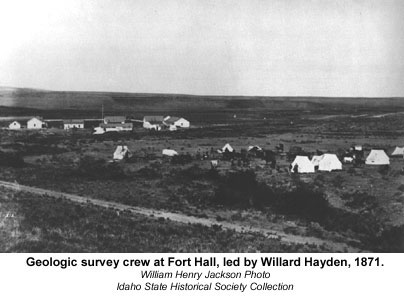Maps, Surveys
& Boundaries
The principal meridians and
base lines of the west are a product of the Northwest Ordinance of 1785. This
measure provided for the orderly survey and sale of public lands. During the colonial
period, New England had disposed of public lands by surveying them first and then
selling them in orderly blocks. A system of "indiscriminate locations and
subsequent survey" prevailed in the southern colonies. This permitted settlers
to lay out the land they desired where they wished and then have it surveyed.
The southern system led to conflicting titles as pioneers laid out irregularly
shaped plots to claim the most fertile land and made it impossible for the government
to dispose of the less desirable tracts. The survey of public lands was originally
evolved in Ohio and was well developed by the time the West was settled.
 The
Ordinance of 1785 provided that the public lands of the United States be divided
by lines intersecting true north and at right angles to form townships and ranges
- both six miles square. The townships and ranges were to be marked with progressive
numbers from the beginning, or "initial" point that was surveyed in
a given area. Such townships and ranges were to be divided into thirty-six sections,
each one mile square and containing 640 acres. The sections were to be numbered
respectively, beginning with the number one in the northeast section and proceeding
west and east alternately through the township with progressive numbers to thirty-six.
The
Ordinance of 1785 provided that the public lands of the United States be divided
by lines intersecting true north and at right angles to form townships and ranges
- both six miles square. The townships and ranges were to be marked with progressive
numbers from the beginning, or "initial" point that was surveyed in
a given area. Such townships and ranges were to be divided into thirty-six sections,
each one mile square and containing 640 acres. The sections were to be numbered
respectively, beginning with the number one in the northeast section and proceeding
west and east alternately through the township with progressive numbers to thirty-six.
Note that townships
are counted north-south of the initial point, while ranges are counted east-west.
In order to complete this
type of surveying task, it was necessary to establish independent initial points
to serve as bases for surveys. Principal meridians (north-south lines) and baselines
(east-west lines) were then surveyed from these initial points. Guide meridians
were initiated at baselines, and standard parallels were initiated at principal
meridians to form townships.
 In
Idaho the Initial
Point is located about 8 miles south of Kuna. It is a volcanic hill
that was precisely located on April 19, 1867. Peter W. Bell used stellar observations
to locate the point, by order of Lafayette Cartee, the first surveyor general
of Idaho Territory. The Initial Point is marked with a small, round brass marker
(about the size of a jam jar lid), and the hill is visible for miles around.
In
Idaho the Initial
Point is located about 8 miles south of Kuna. It is a volcanic hill
that was precisely located on April 19, 1867. Peter W. Bell used stellar observations
to locate the point, by order of Lafayette Cartee, the first surveyor general
of Idaho Territory. The Initial Point is marked with a small, round brass marker
(about the size of a jam jar lid), and the hill is visible for miles around.
The principal meridian
for Idaho is the exact north-south line as measured at Initial Point. It was
called the Boise Meridian, and it runs the entire length of Idaho - from the
Nevada border to the border with British Columbia.
The city of Meridian was
named for the Boise Meridian as it lies exactly north on the surveyors line.
All surveys
conducted in Idaho which divided the almost 54 million acres of unmapped lands
are based from Initial Point.
Click
here if you need
to review some mapping terms & basics.
 The
Ordinance of 1785 provided that the public lands of the United States be divided
by lines intersecting true north and at right angles to form townships and ranges
- both six miles square. The townships and ranges were to be marked with progressive
numbers from the beginning, or "initial" point that was surveyed in
a given area. Such townships and ranges were to be divided into thirty-six sections,
each one mile square and containing 640 acres. The sections were to be numbered
respectively, beginning with the number one in the northeast section and proceeding
west and east alternately through the township with progressive numbers to thirty-six.
The
Ordinance of 1785 provided that the public lands of the United States be divided
by lines intersecting true north and at right angles to form townships and ranges
- both six miles square. The townships and ranges were to be marked with progressive
numbers from the beginning, or "initial" point that was surveyed in
a given area. Such townships and ranges were to be divided into thirty-six sections,
each one mile square and containing 640 acres. The sections were to be numbered
respectively, beginning with the number one in the northeast section and proceeding
west and east alternately through the township with progressive numbers to thirty-six. In
Idaho the
In
Idaho the